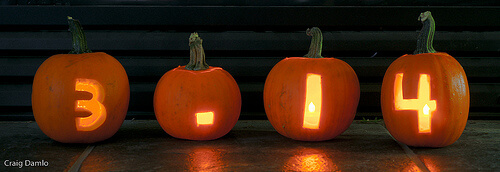
Pumpkins are everywhere you go this time of year, so why not use them to do fall math activities with your kids? There are plenty of pumpkin shapes and sizes to choose from, as there are piles of pumpkins stationed in front of most grocery stores just waiting for people to take them home. You can also go on a fun outing to the pumpkin patch to select the perfect pumpkins for these fall math activities.
Fall math activities for young children:
Regardless of what you plan to do with your pumpkin, the first step for most pumpkin projects is to remove the slimy seeds. This messy sensory activity can also create some fall math activities for your family’s young children.
Activity #1- Practice Estimating:
Each family member can estimate (or guess) how many pumpkin seeds will be inside the pumpkin. If your family has chosen more than one pumpkin, you can guess which pumpkin will have more or fewer seeds.
Activity #2- Count the Pumpkin Seeds:
Once everyone has guessed how many pumpkin seeds there are, everyone can help remove them. As you clean the seeds, have the younger kids in your family count how many seeds are inside the pumpkin. If each family member has their own pumpkin, you can count your own seeds and compare whose estimates were the most accurate.
Fall math activities related to Geometry:
Activity #3- Simple Geometry and Shapes:
Pumpkins are great for teaching kids about geometric shapes. You can talk with your kids about the shape of the pumpkin. Help them understand that it is not just round but more like a ball or a sphere. If you are going to carve faces out of the pumpkin, talk about the different shapes that make up the face, like triangles for the eyes or an oval for the nose.
(The following are geometry-related fall math activities for the older children in your family)
Activity #4- Measure the Circumference of the Pumpkin:
This activity can be done simultaneously as the younger children in your family are counting their pumpkin seeds. They can use a soft measuring tape or a string to determine the circumference of their pumpkin. Once they measure with the string, they can measure the length of the string with a ruler.
Activity #5- Find the Radius and Diameter of the Pumpkin:
Once you have the pumpkin’s circumference, you can use the formula C= 2 x pi x r to find the radius. Or divide the circumference by 2 x pi to find the radius. The diameter is just two times the radius. If you cut the pumpkin open for baking, you can also measure its radius and diameter with string or measuring tape.
Activity #6- Find the Volume of the Pumpkin:
Once your child has found the Circumference and the radius of their pumpkin, they can use those measurements to determine the approximate volume of the pumpkin by using the formula V= (4/3) x pi x radius3.
Note: These measurements will not be perfectly accurate because the pumpkin is not a perfect sphere, but it is an excellent activity to get children to grasp the concepts of these measurements more physically than just looking at drawings on a piece of paper.
Making a pumpkin pie and learning about fractions:
Baking a pumpkin pie is not only a yummy fall dessert, but it can also be one of the fall math activities that can teach your kids about fractions.
Activity #7- Make a Pumpkin Pie:
Baking is a great way for kids to use math as they measure the ingredients or adjust the recipe. For example, if you are making two pies, you can have your children double the measurements for each ingredient.
Activity #8- Pumpkin Pie Fractions:
You can ask your child to figure out how many pieces of pie you will need to cut so that each family member can have one slice. Then after serving one slice of pie you can ask them to figure out what fraction of the pie has been served and what fraction of the pie remains.
These are just a few pumpkin related fall math activities you can do with your kids. If you haven’t gone to the pumpkin patch to pick out your pumpkins there is still time! Take advantage of pumpkin season and do some pumpkin related fall math activities with your family.




